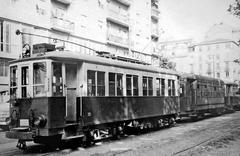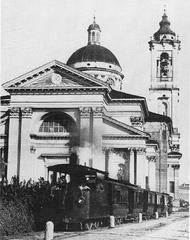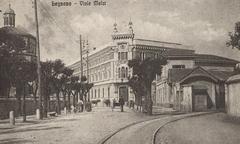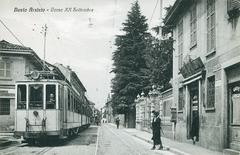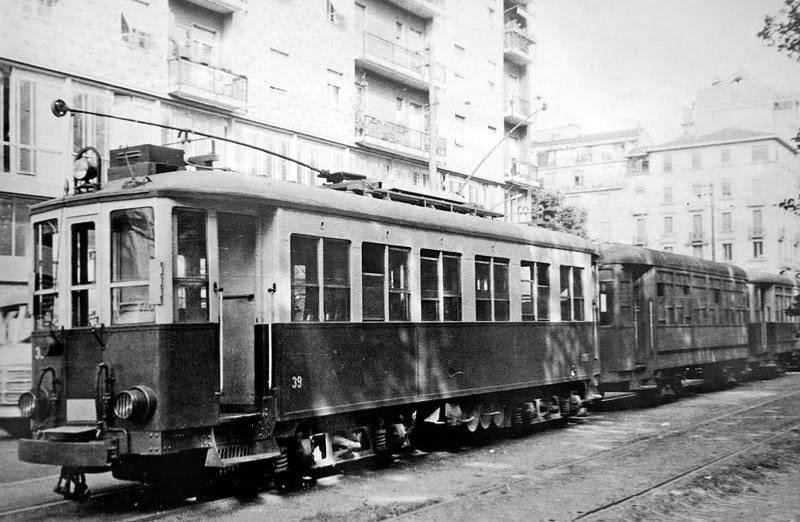
Milan Gallarate Tramway Visiting Hours, Tickets, and Travel Guide
Date: 14/06/2025
Introduction: The Milan-Gallarate Tramway’s Historical and Cultural Significance
The Milan-Gallarate Tramway is a remarkable symbol of Milan’s transformation from a burgeoning industrial center to a vibrant modern metropolis, all while maintaining a strong link to its transport heritage. Established in the late 19th century, this tramway originally connected Milan’s city center to the northwestern suburbs and beyond, fostering economic growth and urban expansion through cutting-edge electric traction. Though the original interurban line is no longer fully operational, its legacy is preserved through heritage tram services, integrated transit, and the city’s ongoing dedication to accessible and sustainable mobility.
Today, you can relive this chapter of Milanese history by riding vintage trams—such as the iconic 1928 Ventotto and 1500 series—along picturesque routes that pass landmarks like the Duomo, Castello Sforzesco, and the Navigli canals. These journeys offer not just transport but also a window into Milan’s commitment to preserving cultural identity while advancing urban innovation.
This comprehensive guide explores the Milan-Gallarate Tramway’s evolution, practical visitor information—including tickets and visiting hours—accessibility details, sightseeing recommendations, and travel tips. Whether you’re passionate about history, fascinated by public transport, or simply seeking authentic Milanese experiences, this article will help you enjoy and appreciate the tramway’s enduring significance in Milan’s urban landscape.
For authoritative updates and information, consult official and expert sources (ATM Official Website, YesMilano Tram Itineraries, Mediolan Public Transport).
Table of Contents
- Introduction: Exploring Milan with the Milan-Gallarate Tramway
- Historical Evolution and Socio-Economic Impact
- Modern Integration and Urban Connectivity
- Visitor Information: Tickets, Hours, and Accessibility
- Recommended Tram Routes and Major Attractions
- Special Heritage Experiences, Tours, and Events
- Safety, Etiquette, and Local Customs
- Tips for a Memorable Visit
- Frequently Asked Questions (FAQ)
- Conclusion: Embrace Milan Through the Milan-Gallarate Tramway
- Sources and Further Reading
Historical Evolution and Socio-Economic Impact
Early Development and Expansion
Conceived amid Milan’s industrial boom, the Milan-Gallarate Tramway was created to connect Milan with Gallarate and other Lombardy towns, supporting the flow of commuters and goods. The adoption of electric traction (600V DC) marked a leap forward in technology and efficiency (Railway Technology). Managed by Azienda Trasporti Milanesi (ATM) from 1931, the tramway played a significant role in supporting suburban growth and economic integration.
Technological Innovations
The tramway became renowned for its advanced rolling stock, including the 1928 Ventotto (Peter Witt) trams, celebrated for their wooden interiors and elegant design. Later, larger “Jumbo” 4900 series trams were introduced to meet growing demand (YesMilano).
Socio-Economic and Cultural Influence
Beyond transportation, the tramway helped shape Milan’s urban development, enabling suburbanization and creating new residential and commercial hubs. Landmarks and tram stops became focal points for local communities, embedding the tramway in Milanese identity (YesMilano).
Decline and Transformation
The rise of private cars and railways after World War II led to the gradual closure of many interurban lines, including the Milan-Gallarate route. However, Milan’s tram network remained a vital component of daily life, blending heritage infrastructure with modern transit (Railway Technology).
Modern Integration and Urban Connectivity
Today, Milan’s tram system is among Europe’s most extensive, with nearly 298 km of track (Railway Technology). The Milan-Gallarate route’s legacy is reflected in the continued operation of vintage trams and the seamless integration of trams with metro, bus, and suburban rail services (mediolan.pl). Modern low-floor vehicles ensure accessibility, while digital ticketing and real-time updates enhance convenience.
The tramway passes through dynamic neighborhoods and serves as a link to key historical and cultural sites, contributing to Milan’s sustainable mobility strategy and unique streetscape.
Visitor Information: Tickets, Visiting Hours, and Accessibility
Operating Hours
- General Service: Trams operate daily from approximately 4:30–6:00 AM until 1:00–2:30 AM.
- Heritage Trams: Vintage trams such as the Ventotto typically run on lines #1 and #10, with special heritage rides scheduled during weekends or city events. Confirm specific times via the ATM website or app.
Ticketing and Fares
- Single Ticket: €2.00, valid for 90 minutes with unlimited transfers within the ATM network.
- Day Pass: €7.00 for 24 hours, €12.00 for 48 hours.
- Tourist Cards: MilanoCard (from €12) grants unlimited travel and discounts on top sites.
- Purchasing Options: Tickets available at metro stations, newsstands, authorized retailers, ticket machines, or digitally via the ATM Milano app.
- Contactless Payment: Most trams accept contactless cards and mobile wallets.
- Validation: Validate your ticket before or immediately upon boarding.
Accessibility
- Low-Floor Trams: Most vehicles are accessible; some historic trams may have steps.
- Accessible Stops: Many stops have ramps and tactile paving. ATM staff offer assistance, and signage is often available in English.
Recommended Tram Routes and Major Attractions
- Line 1: Connects the city center to the Sforza Castle, passing the Duomo and Brera district.
- Line 3: Scenic route through historic neighborhoods and close to cultural attractions.
- Line 12: Direct access to the Navigli canals, renowned for nightlife and dining.
- Line 27: Travels through charming residential areas and local markets.
Trams provide convenient access to major sites such as the Duomo di Milano, Galleria Vittorio Emanuele II, Castello Sforzesco, and La Scala Opera House.
For route planning and real-time schedules, utilize the Giromilano online tool or the ATM Milano app.
Special Heritage Experiences, Tours, and Events
- Historic Tram Rides: Enjoy journeys on the iconic 1500 series and Ventotto trams, featuring wooden interiors and vintage charm (Wikipedia: Trams in Milan).
- Themed Experiences: Look for gourmet dinners and guided tours aboard historic trams (Ready Set Italy: Milan Travel Guide).
- Events: ATM and cultural groups occasionally host special rides and depot tours—check official listings for details.
Safety, Etiquette, and Local Customs
- Security: Milan trams are safe, but remain vigilant for pickpockets, especially during rush hours.
- Etiquette: Allow passengers to exit before boarding, keep conversations quiet, and validate your ticket to avoid fines.
- Local Customs: Trams are an integral part of Milanese culture—respect the space and enjoy the local rhythm.
Tips for a Memorable Visit
- Plan Ahead: Use digital apps for real-time schedules and connections.
- Travel Off-Peak: Avoid rush hours (7:30–9:30 AM, 5:00–7:00 PM) for a more comfortable experience.
- Photography: The trams and cityscape offer excellent photo opportunities—be considerate of other passengers.
Frequently Asked Questions (FAQ)
Q: Where can I buy tramway tickets?
A: Tickets are available at metro stations, newsstands, authorized retailers, and via the ATM Milano app.
Q: What are the tram operating hours?
A: Daily from around 4:30–6:00 AM to 1:00–2:30 AM, with special heritage trams on select routes.
Q: Are Milan’s trams accessible for people with disabilities?
A: Yes, most modern trams and stops are accessible; older vintage trams may have limited access.
Q: Can I use contactless payment?
A: Yes, most trams support contactless and mobile payments.
Q: Are there guided tours on the Milan-Gallarate tramway?
A: Special heritage tours and events are occasionally available—check ATM and tourism sites for announcements.
Conclusion: Embrace Milan Through the Milan-Gallarate Tramway
The Milan-Gallarate Tramway is an essential thread in the fabric of Milan’s past and present. Riding its trams is both a practical way to explore the city and a chance to engage with a living symbol of Milanese history, culture, and sustainability. With convenient ticketing, accessible services, and connections to top attractions, the tramway invites every visitor to experience Milan authentically.
For up-to-date schedules and travel information, download the ATM Milano app, consult official resources, and follow local tourism updates. Step aboard, and let Milan’s trams guide you through a city where the past and future ride side by side.
Sources and Further Reading
- ATM Official Website
- YesMilano Tram Itineraries
- Mediolan Public Transport
- Railway Technology Milan Metro
- UrbanRail.net: Milan Metro
- Wikipedia: Trams in Milan
- Ready Set Italy: Milan Travel Guide
- MilanoExplorer: Public Transport in Milan
- Overyourplace: Milan Cultural Guide
Visuals and Media: For an enriched experience, view images of the Milan-Gallarate tramway in the city center, historic Carrelli trams, and route maps, all available on official websites and tourism platforms. Include descriptive alt text for SEO.
